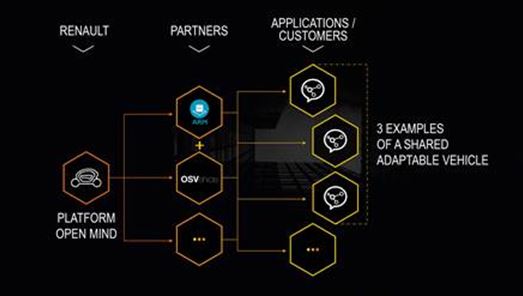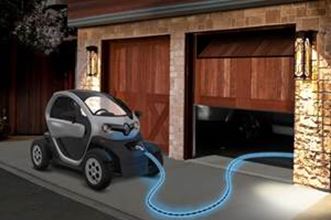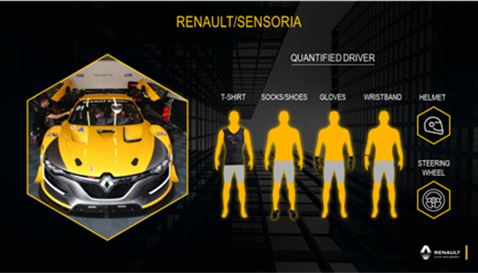Innovative mobility solutions on show at CES 2017
Four of Groupe Renault's strategic technology partners – OSVehicle, ARM, Pilot and Sensoria - are presenting open-innovation and open-source projects at CES this week, illustrating new ways of thinking about mobility as technology meets transportation.
With an open-approach to innovation, Renault and its partners are exploring the changing face of the automotive industry through early hardware and software modification, the addition of new, customisable features and aftermarket opportunities.
Renault-Nissan Alliance Chairman and CEO Carlos Ghosn is also at CES, showcasing his Nissan keynote solutions, of which many have been developed as part of the Alliance converged engineering function and shared technology.
“Renault has been making cars for more than 100 years and our industry is changing rapidly. Being able to work in all new ways, incorporating new technology with new scenarios in mind, ensures we’re constantly exploring new areas of transportation, connected cars, zero emissions and an easier life for our customers,” said Pierrick Cornet, VP Engineering, Groupe Renault, “CES is one of the world’s great stages for what’s next in consumer technology and we’re excited to be here with our partners and through the Renault-Nissan Alliance.”
'The world's first open-source mass-market vehicle'
Based on Twizy, Renault has developed POM, a compact and lightweight electric vehicle with bodywork parts removed and an open-source automotive platform. Available to startups, independent laboratories, private customers and researchers, it allows third parties to copy and modify existing software to create a totally customisable electric vehicle.
In partnering with OSVehicle to develop an open-source platform readily accessible to the community, OSVehicle also provides on-demand design and engineering services for complete personalisation. Bringing together a rich ecosystem of entrepreneurs, developers, designers, and engineers, OSVehicle makes it easier to build, share, distribute and modify the hardware designs of electric vehicles.
“We are very excited to welcome a great Auto OEM like Renault in our open ecosystem,” said Tin Hang and Yuki Liu, Founders of OSVehicle. “We are sure that our community will benefit and provide value to the automotive industry, contributing with new mobility solutions and solving specific needs with a wider range of connected car and self-driving technologies. Sharing common hardware platforms to everyone is a new co-creative and horizontal approach that can disrupt this industry lowering significantly costs and time-to-market.”
Providing processor design technology powering more than 80% of mobile computing devices, Renault’s collaboration with ARM will open up the Twizy software and hardware architecture to allow new features, including interoperability with ARM-based connected devices. The ARM ecosystem is scaling the ARM architecture to address a diverse range of automotive technology use cases in support of ADAS, IVI, autonomous driving, advanced cockpits and connected car.
“Connected vehicles will enable new business models that deliver a broad range of choices and experiences for end users,” said Richard York, Vice President of embedded marketing, ARM. “The automotive industry will increasingly focus on the specific functionality that owners want, such as comfort level and entertainment. By providing this platform, Renault is paving the way for innovation in these areas.”
Visual fun
Renault and Pilot, a retail supplier of mobile electronics and automotive accessories are exploring aftermarket opportunities beyond the traditional automotive sphere. By combining Pilot’s Light Pulse Cable technology with Renault’s knowledge of electric mobility, they claim to have created the world’s first electroluminescent charging cable for electric vehicles.
Designed to connect an electric vehicle to its charging point, the cable indicates the existing charge level by illuminating and flashing on and off in proportion to electricity flow. The lower the charge level, the higher the current flow and the faster the flash rate of the exterior cable sheath. The flash rate will slow down as the battery charges, switching off completely when fully charged. This technology is inspired by a cable recently brought to market by Pilot for smartphones and tablets based on the same principle.
“We’re genuinely excited about our partnership to co-develop new technologies with the Renault team who share Pilot’s passion in the earnest pursuit of true innovation,” said Calvin Wang, CEO, Pilot.
For the weekend racer
Combining more than a century of racing experience with an expertise in smart garments, including an intelligent T-shirt which records a driver’s heart rate, Renault and Sensoria are collaborating to develop sensitive socks to improve drivers’ footwork. The information gathered by the connected socks is transmitted to an app that records various parameters (speed, braking and acceleration), allowing racing car enthusiasts to assess their performance on the track.
“Our team is thrilled to collaborate with Renault to expand our wearable technology line and help drivers improve their racing performance,” said Davide Vigano, Co-founder and CEO of Sensoria. “Motorsport enthusiasts are in need of more seamless and accurate data collection methods. With Sensoria at the forefront of Internet of Me technologies, our garments are the perfect solution for drivers looking to take their racing to the next level.”





